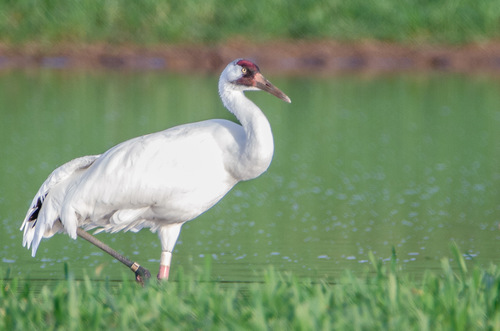
Whooping Crane
The Whooping Crane (Grus americana) is a critically endangered crane species, renowned as the tallest bird in North America. It is a symbol of conservation efforts, having been brought back from the brink of extinction. These majestic birds play a crucial role in wetland ecosystems, and their recovery is a testament to dedicated conservation work. Historically, they held significance for some indigenous cultures, often symbolizing longevity and good fortune.
130-160 cm
Length
210-230 cm
Wingspan
Endangered
Conservation Status
Distribution
The primary wild population breeds in Wood Buffalo National Park, Canada, and winters along the Gulf Coast of Texas, primarily in and around Aransas National Wildlife Refuge. A non-migratory reintroduced population exists in central Florida, and other reintroduction efforts are underway in Louisiana.
Lifespan
22-30 years in the wild; up to 40 years in captivity.
Whooping Crane's Habitat
Habitat Types
Wetlands, Marshes, Shallow bays, Tidal flats, Agricultural fields (during migration)
Climate Zones
Temperate, Subarctic (breeding grounds)
Adaptations
Their long legs and necks are adapted for wading in shallow water and foraging for food. Their broad wingspans are suited for long-distance migration.
Variations
No recognized subspecies exist.
Appearance
Breeding Plumage
Adult plumage is primarily white with black wingtips (primaries), a red crown, and black legs and feet. There is no significant difference between breeding and non-breeding plumage.
Seasonal Feather Changes
No major seasonal variations. Juveniles have a mix of cinnamon-brown and white feathers.
Sex Based Plumage Differences
Minimal sexual dimorphism in plumage; males and females look very similar.
Notable Features
Red crown, Black wingtips (visible in flight), Long legs and neck, Black 'mustache' (malar region)
Diet and Feeding
Primary Foods
Blue crabs, Clams, Small fish, Insects, Berries, Grains (especially during migration)
Foraging Behavior
Whooping Cranes forage by walking slowly through shallow water or fields, probing the ground or water with their bills. They are opportunistic omnivores.
Specializations
Their long bills are well-suited for probing mud and sand for invertebrates.
Seasonal Diet Variations
Diet shifts seasonally based on availability. In winter, they rely heavily on blue crabs and clams in coastal areas. During migration and breeding, they consume more insects, grains, and berries.
Behavior
Social Structure
Whooping Cranes are generally territorial during the breeding season. They form family groups and may congregate in larger flocks during migration and winter.
Communication
Loud, bugling calls (the 'whoop' that gives them their name), Visual displays (dancing, bowing, wing-flapping), Unison calls (synchronized vocalizations by pairs)
Migration
The main wild population undertakes a long-distance migration of approximately 4,000 km (2,500 miles) between Wood Buffalo National Park and Aransas National Wildlife Refuge. Migration is learned by young cranes from their parents.
Territorial or Group Behaviors
Highly territorial during breeding season, defending nesting and feeding areas. More social during migration and winter, forming larger flocks.
Conservation
Threats
Habitat loss and degradation, Collisions with power lines, Illegal hunting (though rare now), Climate change (affecting water levels and food availability), Low genetic diversity
Protection Programs
Captive breeding and reintroduction programs, Habitat restoration and protection, Monitoring of wild populations, Public education and outreach, International Crane Foundation initiatives
Local National Laws
Protected under the U.S. Endangered Species Act and the Species at Risk Act in Canada.
Population Trend
Increasing
Population Estimates
Over 800 individuals (wild and captive) as of 2023, up from a low of only 15 birds in 1941.
Interesting Facts
They are one of the rarest birds in North America.
Their near extinction and subsequent recovery is a major conservation success story.
Their 'whoop' call can be heard up to 2 miles away.
This loud call is used for communication, especially during courtship and territorial defense.
Whooping Crane chicks can swim shortly after hatching.
This adaptation helps them escape predators in their wetland habitat.
They are the tallest bird in North America
Standing at nearly 5 feet tall.
Faqs about Whooping Crane
What is the biggest threat to Whooping Cranes?
Historically, habitat loss was the primary threat. While habitat loss remains a concern, collisions with power lines and the effects of climate change are also significant threats.
Why are they called Whooping Cranes?
They are named for their loud, distinctive 'whooping' call.
Can I see Whooping Cranes in the wild?
Yes, but viewing opportunities are limited. The best places are Aransas National Wildlife Refuge in Texas during the winter and Wood Buffalo National Park in Canada during the summer. Respectful viewing distances are crucial to avoid disturbing the birds.
Are Whooping Cranes still endangered?
Yes, they are still classified as Endangered by the IUCN, but their population is increasing thanks to dedicated conservation efforts.
Copyright @ Nature Style Limited. All Rights Reserved.
 English
English